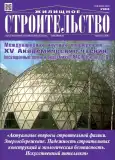On the Size of the Step Along the Azimuth of the Wind Flow During Aerodynamic Studies of High-Rise Buildings
- Authors: Pastushkov P.P.1,2, Sinyavin A.A.1, Chulyunin A.Y.1
-
Affiliations:
- Lomonosov Moscow State University
- Scientific-Research Institute of Building Physics of RAACS
- Issue: No 6 (2024)
- Pages: 49-52
- Section: Articles
- URL: https://journals.eco-vector.com/0044-4472/article/view/634825
- DOI: https://doi.org/10.31659/0044-4472-2024-6-49-52
- ID: 634825
Cite item
Abstract
In recent decades, high-rise construction has been actively developing in the Russian Federation. This led to a significant increase in aerodynamic studies of high-altitude objects in accordance with the methodology of SP 20.13330.2016 «SNiP 2.01.07-85* Loads and Impacts». In many domestic and foreign works, when conducting such studies, the step in the azimuth angle of the wind flow is 15 degrees (less often 20 degrees). This paper presents results that show that such a wind azimuth step, in conditions of dense multi-height buildings, results in a significant underestimation of local negative peak wind loads. The question of sufficiency of the wind flow azimuth step of 5 degrees is discussed.
Full Text
About the authors
P. P. Pastushkov
Lomonosov Moscow State University; Scientific-Research Institute of Building Physics of RAACS
Author for correspondence.
Email: pavel-one@mail.ru
Candidate of Sciences (Engineering), Research Institute of Mechanics
Russian Federation, 1 Michurinskii prosp. Moscow, 119526; 21, Lokomotivniy Driveway, Moscow, 127238A. A. Sinyavin
Lomonosov Moscow State University
Email: sinjavinaa@yandex.ru
Candidate of Sciences (Physics and Mathematics), Research Institute of Mechanics
Russian Federation, 1 Michurinskii prosp. Moscow, 119526A. Yu. Chulyunin
Lomonosov Moscow State University
Email: chulyu-n@mail.ru
Senior Researcher, Research Institute of Mechanics
Russian Federation, 1 Michurinskii prosp. Moscow, 119526References
- Poddaeva O., Fedosova A, Churin P, J. Gribach J. Conducting experimental investigations of wind influence on high-rise constructions. E3S Web of Conferences. 2018. Т. 33. DOI: https://doi.org/10.1051/e3sconf/20183302067
- Goryachevsky O. Numerical modelling of wind loads on windows. Validation for a high-rise square plan building. International Journal for Computational Civil and Structural Engineering. 2023. 19-3, pp. 114–129. DOI: https://doi.org/10.22337/2587-9618-2023-19-3-114-129
- Poddaeva O.I., Fedosova A.N., Gribach J.S. Experimental studies of wind impact on religious buildings. IOP Conference Series: Materials Science and Engineering, 2021. Vol. 31 (1). 012046. https://doi.org/10.1088/1757-899X/1015/1/012046
- Ke Y., Shen G., Yu H., Xie J. Effects of corner modification on the wind-induced responses of high-rise buildings. Applied Sciences. 2022. 12(19):9739. DOI: https://doi.org/10.3390/app12199739
- You H. Si C. Ma X., Shang J. Overall and local wind loads on post-installed elevator shaft of existing Buildings. Buildings. 2024. 14 (1):110. DOI: https://doi.org/10.3390/buildings14010110
- Flaga A., Kocon A., Kłaput R., Bosak G. The environmental effects of aerodynamic interference between two closely positioned irregular high buildings. Journal of Wind Engineering and Industrial Aerodynamics. 2018. 180, pp. 276–287. DOI: https://doi.org/10.1016/j.jweia.2018.07.024
- Гувернюк С.В., Гагарин В.Г. Компьютерное моделирование аэродинамических воздействий на элементы ограждений высотных зданий // АВОК. 2006. № 8. С. 18–24. Guvernyuk S.V., Gagarin V.G. Computer modeling of aerodynamic effects on elements of enclosures of high-rise buildings. AVOK. 2006. No. 8, pp. 18–24. (In Russian).
Supplementary files













